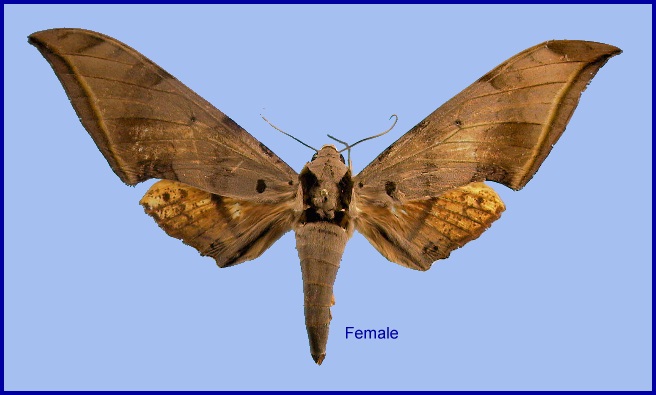
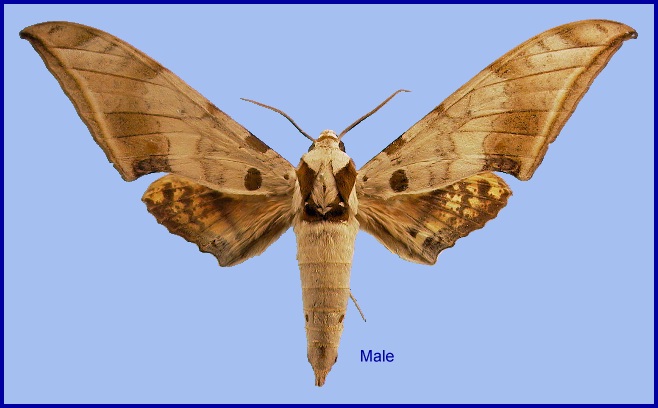
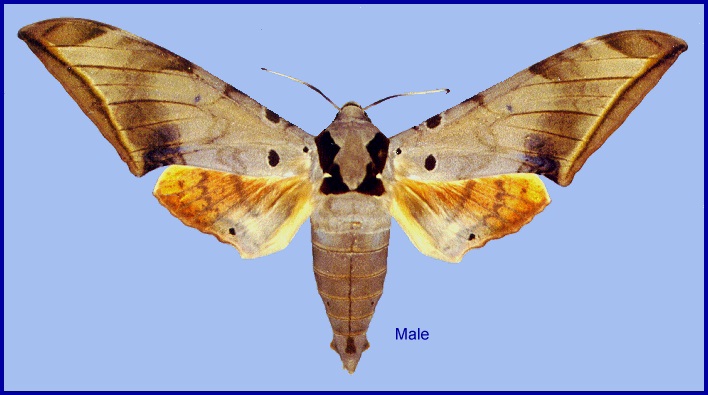
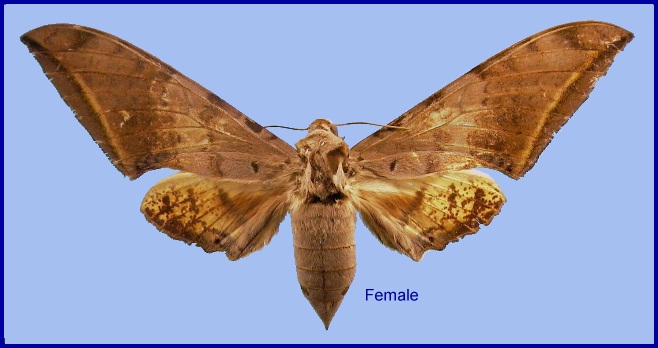
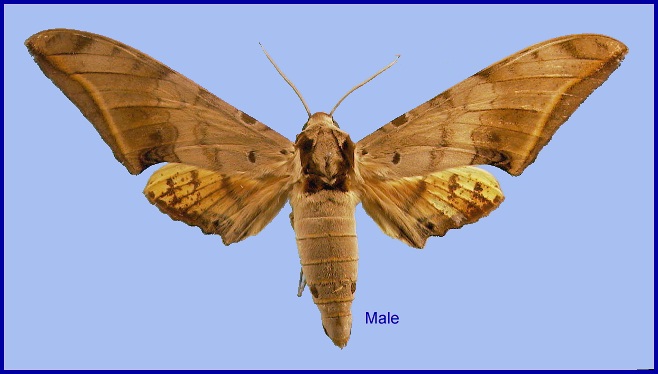
Ambulyx sericeipennis Butler, 1875, Proc. zool. Soc. Lond. 1875: 252. Type locality: Northwest Himalayas [India, Uttarakhand,] Masuri [Mussoorie].
Synonym. Oxyambulyx sericeipennis brunnea (Mell, 1922).
Synonym. Oxyambulyx sericeipennis reducta (Mell, 1922).
Synonym. Oxyambulyx sericeipennis agana Jordan, 1929.
Synonym: Oxyambulyx okurai Okano, 1959, Rep. Gakugei Fac. Iwate Univ. 14: 40. Type locality: Central Formosa [Taiwan, Nantou Hsien], Puli.
Synonym. Oxyambulyx amaculata Meng, 1989.
Wingspan: 95--124mm. Similar to Ambulyx maculifera but greyer and the submarginal band of the forewing upperside extends to the costal and anal margins, whereas it fades before meeting the anal margin in Ambulyx maculifera. Tergum A8 of the male is weakly bi-sinuate, with a dark patch dorsally. There is a distinct mesial line in both sexes. Underside a deep chrome colour.
In the male genitalia, gnathos lobed mesally, with lobe rather narrow and almost truncate. Valva: harpe with a long finger-like process that points ventrad; mesal ridge composed of two lamellae, irregularly dentate an distally produced into a cone, the extreme end of which is turned ventrad. Phallus as in Ambulyx maculifera, with row of teeth dorsally and with some irregular teeth ventrally; vesica with club-shaped cornutus. In the female genitalia, sterigma with mesal lobe longer and broader than in Ambulyx maculifera.
The moth rests with the wings held almost horizontal and the abdomen bent sharply upwards and outwards (Bell & Scott, 1937).
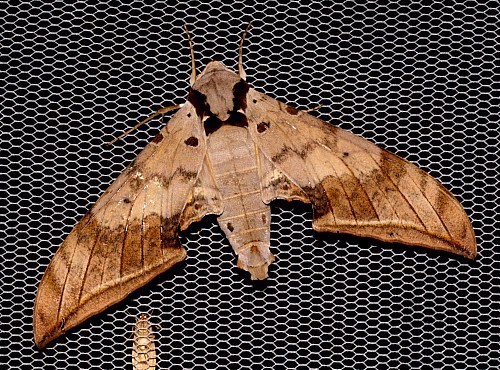
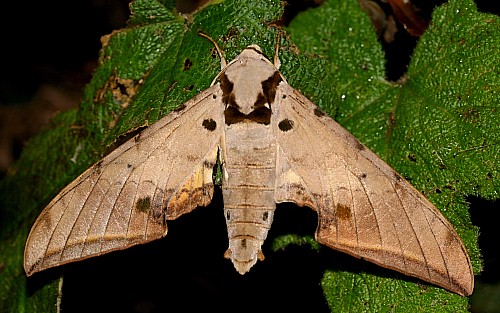
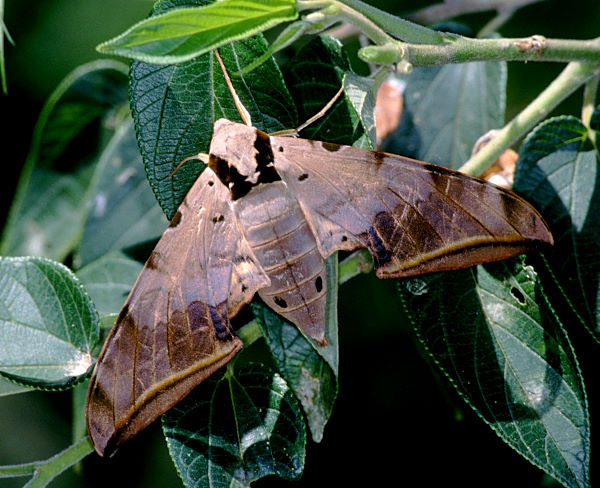
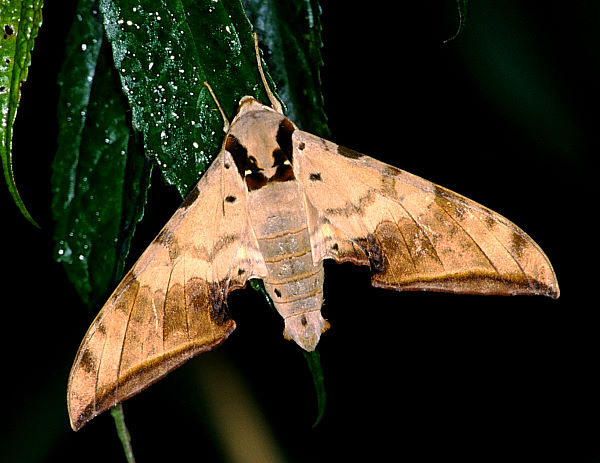
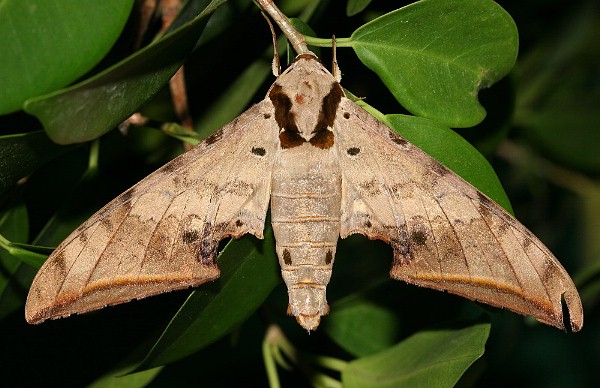
China: i (Yunnan); 10.iii (Yunnan); iii-iv (Hong Kong); iv (Fujian; Guizhou); 29-30.v (Yunnan; Fujian); v-vi (Zhejiang); vi (Shaanxi; Jiangxi; Guangdong; Guangxi); vi-vii (Hong Kong; Sichuan; Guangxi; Chongqing); 14.vii (Zhejiang); 17.vii (Xizang/Tibet); vii-viii (Yunnan; Sichuan); 23.ix (Hunan). Taiwan: iii-v (Kaohsiung Hsien); 6.v (Chiayi Hsien); v-vi (Hualien Hsien); vii (Taitung Hsien; Taipei Hsien); viii-ix (Nantou Hsien; Hualien Hsien; Taipei Hsien; Taichung Hsien).
OVUM: Pale green when first laid, turning after a few days to a beautiful orange, and then, a day or two before hatching, to translucent white. Slightly oval; surface smooth and shiny. Usually laid on the underside, but sometimes on the upper side of a leaf, or on twigs of the hostplant (Bell & Scott, 1937).
LARVA: Full-fed 80mm long, 12mm wide; horn 12-16mm. There are several colour forms. According to Bell & Scott (1937), in the first instar head round, body long and thin, horn long and straight. Surface of head and body smooth and shiny; pale yellow in colour, with the horn black. In the second instar, head triangular, with a short process on apex of each lobe. Body cylindrical, long and thin, horn long and straight. The head and body are yellowish-green, the body with transverse rows of small white tubercles. The horn is dark purple with small tubercles of the same colour. In the third instar, head triangular, very large, with a short process on the apex of each lobe. Segments 3 to 4 of the body much less in diameter than the head, the segments then increasing in diameter to 7. Horn as above; surface of the head moderately shiny; the body dull with tubercles as before. Colour of the head dark green dotted with white. There are two narrow, whitish stripes down the face and one down each cheek. The apical processes are brown, with a brown dorsal stripe running from their tips to the nape. The body is green with yellow tubercles, the oblique lateral stripes on segments 5 to 11 formed of larger yellow tubercles; horn as before. Some specimens have irregular reddish blotches and oblique stripes. In the fourth instar there is little change.
In the fifth and final instar, head triangular, vertex rounded, with a short blunt process on the apex of each lobe, length greater then the diameter of segments 2 and 3, surface of head smooth and shiny, covered with small, low, evenly-spaced tubercles. Body increasing gradually and evenly from segments 2 to 8, and then decreasing slightly to 12. Horn straight, thick at base and tapering evenly to a blunt point. Surface of body dull, with a transverse row of low tubercles on each secondary ring. There is a dorso-lateral line of large pointed tubercles from segment 2 to the base of the horn. The seven oblique lateral stripes are also formed of pointed tubercles and the horn is covered with smaller tubercles.
In colour, head bluish-green, the tubercles white. A narrow white stripe runs along each side of the dorsal line from the vertex to the clypeus apex, and there is a broad white cheek-stripe. Vertex processes pale yellow, with a white subdorsal stripe running from each process to the nape and then joining the subdorsal line of tubercles on the body. Body bright bluish-green, paler below the spiracles, the row of tubercles yellow. The subdorsal dorso-lateral line of tubercles and those forming the oblique lateral stripes yellow. There is also a narrow supraspiracular stripe on segments 2 to 4 which meets the oblique lateral stripe on segment 5 at its lower end; this is also yellow. Horn green, with the tubercles paler green. Legs reddish with a black ring on each segment; prolegs and claspers green.
In another form of the larva the transverse rows of tubercles are white, those forming the subdorsal and oblique lateral stripes mauve; the supraspiracular stripe is also mauve.
In a third form the head-processes and the dorsal stripe down back of the head is brown. The dorso-lateral line of tubercles and supraspiracular stripe whitish, with a broad, irregular, purple-brown band between them and below them on to broad triangular blotches of brown and purple above each oblique lateral stripe, which is orange. Horn dark purple. Legs, prolegs and a large triangle on claspers brown.
There are still other forms intermediate between the above. Spiracles oval, sky blue, with a raised edged to the central slit and a narrow border of paler blue.
The larva lies on the underside of a leaf and adopts the characteristic attitudes of the genus Ambulyx. When full grown it rests without feeding for four or five days before leaving the hostplant to seek a place to pupate, and the dorsum becomes suffused with violet. If touched during this resting period, or while on the ground looking for soft earth to dig in, it jumps violently, bending the head to one side till it touches the claspers and then suddenly to the other side. The movement is so vigorous that the larva sometimes jerks itself off the hostplant on to the ground (Bell & Scott, 1937).
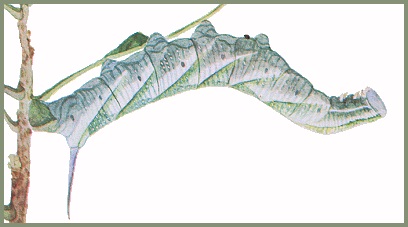
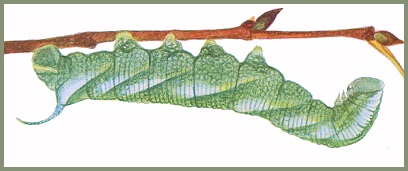
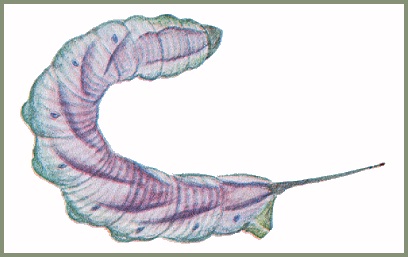

Photos: Larvae of Ambulyx species from China. (A) Ambulyx moorei, Foshan, Guangdong, China; (B) Ambulyx sericeipennis sericeipennis, Hongkong, China; (C) Ambulyx ochracea, Guangzhou, Guangdong, China; (D) Ambulyx kuangtungensis, Guangzhou, Guangdong, China; (E) Ambulyx semiplacida montana, Pingbian County, Yunnan, China; (F) Ambulyx schauffelbergeri, Chongqing City, China; (G) Ambulyx siamensis, Mengla County, Yunnan, China; (H) Ambulyx siamensis, Mengla County, Yunnan, China; (I) Ambulyx liturata, Mt. Maoershan, Guangxi, China; (J) Ambulyx tobii, Kunming, Yunnan, China. (© Jiang, Kitching, Xu, Xu, Yan, Yu, Liu & Hu, 2025)
PUPA: 51mm. Closely resembles others in the genus. Pupation takes place in a cell underground, smoothed and lined with silk. The pupal stage lasts from about three weeks, to many months in the case of hibernating pupae (Bell & Scott, 1937).


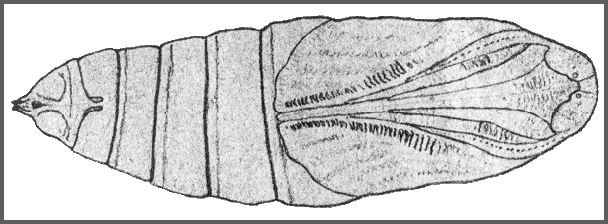
Larval hostplants. Recorded from Juglans regia, Engelhardia spicata, Engelhardia roxburghiana, Elaeocarpus, Quercus, Myrica nagi, Betula alnoides and Rhus (Bell & Scott, 1937; Inoue, Kennett & Kitching, [1996] 1997). Also Rhus chinensis var. roxburghii (DC.) Rehder in Taiwan.
Ichneumonidae: Neofacydes sinensis Heinrich, 1960.
China: Shaanxi (Qingling Shan, Taibai Shan, 1000m); Anhui (Huangshan; Chuzhou); Zhejiang (Tianmu Shan, 920m; Taisunxian; Kuocang Mountain Nature Reserve; Wuchaoshan National Forest Park); Sichuan (Kangding; Xiaolou; Emei Shan; Qionglai Shan, 1200m; Panzhihua Dam, 1130m); Chongqing (Fengjie; Yintiaoling Nature Reserve, Wuxi County, 1270m); Yunnan (??Bahand; Kunming; Yanmen; Baoshan, 1500m; Mengla County, Mt. Leigongyan, 2000m; Simao/Pu'er; Gaoligong Shan; Dali; Yuanjiang); Xizang/Tibet (Lixin Village, Nyalam County, 1370m); Guizhou (Jiucai Ling; Xinzhaidashan, Zhijin County, 1000-2000m; Maolan Nature Reserve, Libo, 896m; Zunyi); Hunan (Fushoushan, 1097m); Jiangxi (Wuyi Shan, Xipaihe village, 1500m; Le'an); Fujian (Fuzhou; 60km NW Longyan, Daimao Shan, 1300m; Youxi County, Sanming, 846m); Guangdong (Shaoguan, Nanling, 1100m; Nanling National Forest Park, 1100m); Hong Kong (Shek Kong); Guangxi (Jinxiu, Dayao Shan, 1200m; Longsheng, 2100m); Hainan (Jianfeng Ling Tropical Forest; Sanya, Mt. Jianfengling; Duowen Ling, nr Lingao).
Taiwan: Yilan Hsien (Fushan, 700m); Hualien Hsien (Taroko National Park; Hungyehtsun); Taipei Hsien (Lala Shan, nr. Wulai; Fushan, 310m); Taichung Hsien (Kukuan); Kaohsiung Hsien (Shanping, 640m); Nantou Hsien (Puli; 3km SW Tsuifeng; Lianhuachih); Taitung Hsien (7km W Taimali); Chiayi Hsien (Alishan, 1450m).
From northern Pakistan (Rafi et al., 2014) and northern India eastwards across Nepal, Sikkim (Khan & Raina, 2017), Bhutan (Irungbam & Irungbam, 2019), Burma/Myanmar, Thailand, Laos, Cambodia and Vietnam (Le & Vu, 2024) to central and southern China, including Taiwan.

Map: Distribution of species of the Ambulyx schauffelbergeri- and Ambulyx kuangtungensis-groups: Ambulyx latifascia (black triangles); Ambulyx kuangtungensis (blue dotted line); Ambulyx schauffelbergeri (red dotted line); Ambulyx sericeipennis sericeipennis (green dotted line); Ambulyx sericeipennis joiceyi (purple triangles); Ambulyx sericeipennis javanica (orange triangles); Ambulyx sericeipennis luzoni (green triangles); Ambulyx sericeipennis palawanica (red triangles); and Ambulyx tobii (yellow patch). (© Jiang, Kitching, Xu, Xu, Yan, Yu, Liu & Hu, 2025).
 Return to Sphingidae of the Eastern Palaearctic species list
Return to Sphingidae of the Eastern Palaearctic species list